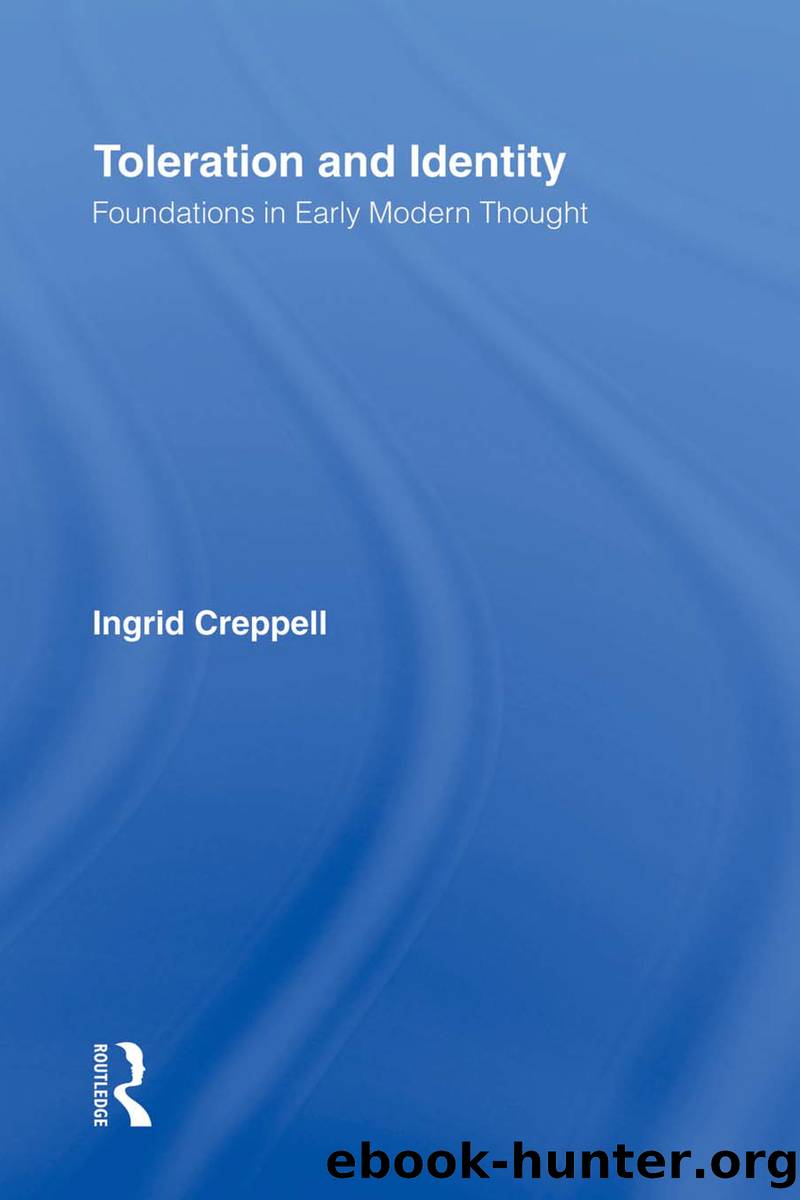Toleration and Identity by Creppell Ingrid;

Author:Creppell, Ingrid;
Language: eng
Format: epub
Publisher: Taylor & Francis Group
Published: 2010-02-15T00:00:00+00:00
Or again, in arguing specifically against a policy of toleration, he wrote of âpeople that are ready to conclude God dishonoured upon every small deviation from that way of his worship which either education or interest hath made sacred to them⦠[people] who are apt to judge every other exercise of religion as an affront to theirs, and branding all others with the odious names of idolatry, superstition or will-worshipâ(161-162, emphasis added). The whole tenor of these passages, as well as specific wordsââenemies,ââCanaanites,ââEgyptians,ââhonour,ââaffrontââattest to Locke's perception of religion as a way in which people group themselves in oppositional terms. When one's fundamental perspective on the world revolves around such categorization of other persons or groups into potential apostates/ heathen versus brethren (strangers/enemies/foreigners versus comrades/ sisters/brothers, etc.), then cues to action will come as responses to what one perceives as threats, affronts, or aggression against one on the basis of this identification. One responds to them as a type and specifically, as a type to beware of: One seeks to protect oneself and those with whom one identifies. Because the categories are so unambiguous, the responses tend to be brittle and quick. For Dissenters and other religious activists during the post-Reformation period, their Christian identity constituted the core way in which they conceived of themselves.
In addition to the positive logic of categorization, two negative logics make accommodation among those holding different religious identities difficult. The first of these might be termed non-negotiability: That is, religious beliefs transformed into identities are not based upon rational argumentation, as Locke noted. The collapsing of distance between the self and belief leads a person to identify him or herself wholeheartedly and uncritically with a particular set of beliefs. Hence, finding some commensurable grounds for reasoning about ways to live together is extraordinarily difficult. In extreme cases, there are no places at which one can find a hook for communication. The identities are based on an all-or-nothing affirmation and unless the sanctity of this commitment is felt to be protected, the believer may not negotiate over particular concerns because the âbargainingâwill be seen as a means to undermine the integrity of the group. The Puritan refusal to make concessions about specific rituals exemplifies this quality: The standards for what will harm and what will not harm the status of the religious group are internal to the belief system or the self-perception of the group and therefore, to find a common language becomes an intractable problem.
The second negative logic of religious identity derives from the fact that religious beliefs, which the person holds to be essential to him, take on a paramountcy that crowds out, or makes subsidiary all other sources of identification and meaning within the person. These beliefs and actions appear not just as one among other modes in which the person could conceive himself: They are necessarily the primary form that pervades and directs all others. The person cannot see alternative views of the self as having much meaning. At the extreme, this monodimensional
Download
This site does not store any files on its server. We only index and link to content provided by other sites. Please contact the content providers to delete copyright contents if any and email us, we'll remove relevant links or contents immediately.
Spare by Prince Harry The Duke of Sussex(4783)
Machine Learning at Scale with H2O by Gregory Keys | David Whiting(3602)
Fairy Tale by Stephen King(2938)
Will by Will Smith(2572)
Hooked: A Dark, Contemporary Romance (Never After Series) by Emily McIntire(2410)
The Bullet Journal Method by Ryder Carroll(2393)
Rationality by Steven Pinker(2146)
It Starts With Us (It Ends with Us #2) by Colleen Hoover(2024)
Can't Hurt Me: Master Your Mind and Defy the Odds - Clean Edition by David Goggins(2001)
Friends, Lovers, and the Big Terrible Thing by Matthew Perry(1988)
The Becoming by Nora Roberts(1912)
Love on the Brain by Ali Hazelwood(1806)
HBR's 10 Must Reads 2022 by Harvard Business Review(1693)
The Strength In Our Scars by Bianca Sparacino(1692)
A Short History of War by Jeremy Black(1665)
515945210 by Unknown(1519)
Leviathan Falls (The Expanse Book 9) by James S. A. Corey(1513)
Bewilderment by Richard Powers(1439)
443319537 by Unknown(1395)
